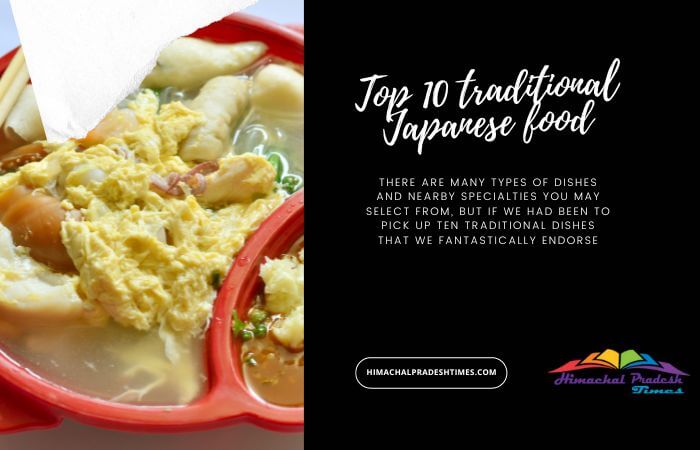While visiting Japan, you will, of course, want to sample Jap food. There are many types of dishes and nearby specialities you may select from, but if we had to pick 10 traditional Japanese foods that we fantastically endorse, they would be the ones listed below.
#1. Sushi
The Sushi is one of the maximum famous traditional Japanese food products globally. it’s far provided in numerous ways and costs, from the pleasing kaiten-zushi (conveyor belt sushi), wherein visitors can experience sushi for a reasonable fee of approximately a hundred yen in line with plate, to excessive-quit, lengthy-installed, conventional Edomae sushi (Edo-style sushi) in which you will sit at a quiet counter to devour as the sushi is ready right earlier than your eyes.
Sushi may be eaten with a baguette or immediately with the hand. But, there may be something you must be cautious approximately. When soaking sushi in soy sauce, you need to flip it upside down and follow the soy sauce to the neta, instead of the rice itself. That is to prevent rice from sucking too much soy sauce and wipe away the authentic Japanese food flavor of the “beta” itself.
Read More: Food Items that you are Going to Enjoy in Himachal Pradesh
#2. Sashimi
Sashimi is also an essential food. Just like sushi, but without rice, sashimi is a raw fish cut into easy-to-eat chunks. The high quality of the fish caught in all areas of Japan makes it an excellent choice, no matter if you visit Tokyo, Kyoto or anywhere else.
Just like sushi, guests can enjoy tens of varieties of sashimi. Some of the more common and popular varieties include maguro and other varieties of tuna, salmon, mackerel and sea bream. You can try clams, sea urchins or salmon eggs as well. Check out what fish and seafood you prefer by ordering a variety
#3. Unagi – Grilled Eel
Unagi or eel is a fish found mostly in rivers. In Japan, it is a delicacy typical of upscale Japanese restaurants. There are also a lot of casual restaurants that specialise in unagi dishes. In unagi restaurants, guests can enjoy kabayaki, where unagi is put on brochettes and grilled with a special sauce containing soy sauce, mirin, sugar and sake. Unadon, a kabayaki dish on white rice, is also available in these facilities.
Hitsumabushi, a Nagoya area of expertise dish, is another traditional Japanese food to try. Its look might also marvel people–cut-up kabayaki on top of white rice–however, it is able to be eaten in several ways, inclusive of with condiments like green onion and wasabi or as ochazuke by pouring warm green tea or broth over it. Unagi is likewise liked as a healthful food to save you summer time warmth fatigue for its proteins, and as it is good for digestion.
#4. Tempura
Tempura is a dish with ingredients such as shellfish, meat and vegetables covered in batter and fried in oil. It usually has flour and eggs in it. Tempura is usually soaked in a special sauce called tentuyu before eating. Tentsuyu is a sauce made of kombu bouillon or dried bonito, mirin and soy sauce mixed in a 4:1:1 ratio and cooked. You can add ginger or grated radish to taste fresher.
#5. Soba and Udon
Soba is a dish of noodles based on buckwheat flour with water and flour, thinly divided and cut into noodles with widths of 1 cm- 2 cm. After boiling the noodles in hot water, it is consumed by dipping them in the cold soup or pouring hot soup over them. Soba stock (tsuyu) is typically made of Kombu or dried bonito stock, seasoned with soy sauce and mirin, and is crucial for having a delicious spa experience.
Soba is enjoyed hot or cold, making it a great dish all year long.
Udon is a special dish known for its thick pasta, and is a very popular and traditional Japanese dish. The dough is made of flour and salted water, well blended and cut into noodles. After the udon noodles are boiled in hot water, udon is enjoyed in the seafood broth soup, or by pouring the soup and toppings as tempura over it. Like Soba, you may enjoy udon hot or cold. It is not the only way to eat udon.
#6. Onigiri – Rice Balls
You may already know about onigiri, or rice balls. Onigiri, also called omusubi, may just look like ordinary rice, but they often have a salted filling inside and are wrapped with a salted nori seaweed leaf. They are manufactured in bento meals by families and often sold in local shops and supermarkets. It is a traditional choice for a snack or light meal.
Although you can make onigiri yourself and buy it at little cost, there are restaurants offering onigiri that you can enjoy at a sit-down meal, handmade by chefs with high-quality ingredients. Onigiri Asakusa Yadoroku in Tokyo is a restaurant that received a Michelin star for its delicious rice balls.
Read More: How to make Green Beans Recipe at Home
#7. Yakitori – Grilled Chicken Skewers
Yakitori is a popular Japanese food where the chicken is cut into small pieces and then placed onto bamboo skewers and grilled. It is often found on izakaya menus and occasional restaurants, which makes it a good option for a night in Japan with friends. It is particularly delicious when combined with liquor. Also, if you go to a Japanese festival, there is a good chance that the food booths will sell this classic dish.
Yakitori is ordered at the restaurant by the chicken party. You can find other types of meat and vegetables on skewers as well. It is usually seasoned slightly with salt when it comes, so take the first mouthful without adding any extra condiments. You can eat that kebab.
#8. Sukiyaki
Sukiyaki is baked in a shallow iron pot, traditionally enjoyed in fall and winter in Japan. It became popular in Japan around the 19th century. Made both in homes and available on menus in restaurants, this is a dish you will want to try when you feel like something hearty.
Sukiyaki is made with many different ingredients, like thin slices of beef, scallions, tomatoes, mushrooms and tofu. Guests cook the dish themselves by grilling the ingredients in the skillet after pouring a few drops of sukiyaki sauce. After the ingredients are thoroughly cooked, to eat sukiyaki in its traditional manner, you dip the meat or vegetables in a bowl of beaten egg.
#9. Oden – Simmered Ingredients
Oden is a dish of a variety of ingredients cooked in broth. The ingredients are intended to bring out the flavour of dashi (generally made from a mixture of seafood and kelp) and have a salty and salty taste. Oden has long been consumed in Japan, and it is believed to have been manufactured during the Murom chi period (1336-1573).
#10. Miso Soup
Miso soup is another well-known Japanese food, renowned for its taste and health benefits. The soup is traditionally drunk with other sides and main courses. A traditional Japanese food typically consists of drinking miso soup every day.
Miso soup is made simply, with the fermented miso base, which has a deep, tasty taste, added to Japanese dashi (conventional bonito and kelp mixture). There are hundreds of regional varieties of miso soup, from single soups made from seaweed and tofu to crab soups and various vegetables.
It is served in most Japanese restaurants in all price ranges; you will find miso soup with teishoku whole meals as well as high-end kaiseki cooking, and everything else.







